
India’s Chandrayaan-3 mission has marked a groundbreaking achievement in lunar exploration, becoming the first mission since Apollo to detect seismic signals from the Moon’s south pole. Over 250 seismic events have been recorded, with this milestone representing a major leap forward in understanding the Moon’s seismic landscape.
The Significance of Seismic Signals
Among the 250 seismic signatures detected by Chandrayaan-3, 50 have been classified as unique, potentially indicating the occurrence of “moonquakes.” Similar to earthquakes on Earth, moonquakes provide valuable information about the Moon’s internal structure and tectonic activity. However, this is the first time seismic data has been successfully collected from the Moon’s elusive south pole—a region previously unexplored in this context. The insights gained from these signals could offer clues about the Moon’s composition and its evolution over billions of years.
Cutting-edge Instrumentation and Data Collection
At the heart of this discovery is the Instrument for Lunar Seismic Activity (ILSA), housed within the Vikram Lander. Operating from August 24 to September 4, 2023, at coordinates 69.37° S and 32.32° E, ILSA is the first instrument based on MEMS (Micro-Electro-Mechanical Systems) technology designed to measure lunar seismic activity. Using advanced silicon micromachining techniques, it captured these seismic signals with unprecedented precision. The ILSA’s success marks a major advancement in lunar seismic monitoring, providing more detailed insights than ever before.
The Nature of Detected Signals
Of the 250 seismic events detected, about 200 were found to be related to mission activities. These included movements of the Pragyan rover and the operation of scientific instruments like the ChaSTE thermal probe and the Alpha Particle X-ray Spectrometer (APXS). However, the remaining 50 signals were categorized as “uncorrelated,” meaning they may be genuine moonquakes, unrelated to mission operations. This classification makes them of particular interest to scientists.
One of the most striking findings was the longest continuous seismic signal, which lasted for 14 minutes, raising new questions about its source. This uncorrelated seismic activity could help unravel mysteries about the Moon’s tectonics and could have implications for future lunar missions aimed at deeper exploration.
Scientific Implications and Future Investigation
These seismic findings, published in the renowned scientific journal ICARUS, have already captured the attention of the scientific community. Dr. Sriram, Director of the Laboratory for Electro-Optical Systems (LEOS), emphasized that further analysis of these uncorrelated signals is necessary to fully understand their origins. Investigating these unique seismic events could lead to significant breakthroughs in understanding the Moon’s interior structure, which has remained elusive since the Apollo missions.
Chandrayaan-3: A Mission of Historic Importance
Chandrayaan-3, India’s third lunar mission, was launched on July 14, 2023, with the specific goal of achieving a soft landing on the Moon’s surface. The mission consists of a lander, Vikram, and a rover, Pragyan. Unlike Chandrayaan-2, it does not include an orbiter. After a successful landing on August 23, 2023, Chandrayaan-3’s focus has been on exploring the Moon’s south pole, a region considered key to understanding the lunar environment and potentially hosting water ice—crucial for future lunar colonization.
India’s Chandrayaan-3 mission has opened a new chapter in lunar exploration. Its detection of over 250 seismic signals, particularly from the Moon’s south pole, represents an extraordinary achievement, positioning India as a leader in lunar science. These findings not only contribute to our understanding of the Moon but also pave the way for future missions to delve deeper into its seismic mysteries.

